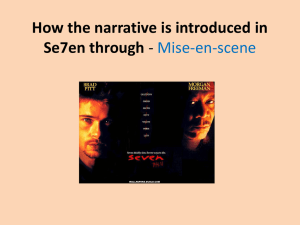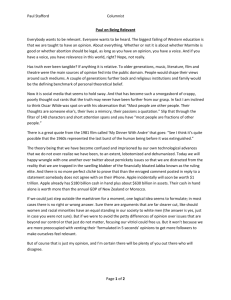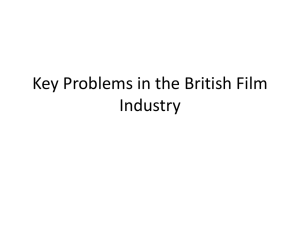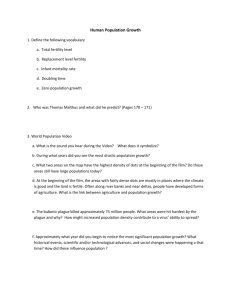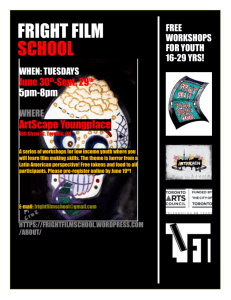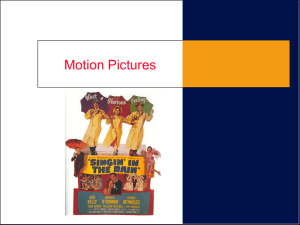NOVEMBER 8, FRIDAY AT 7PM Gun Crazy (Joseph H. Lewis, USA
advertisement
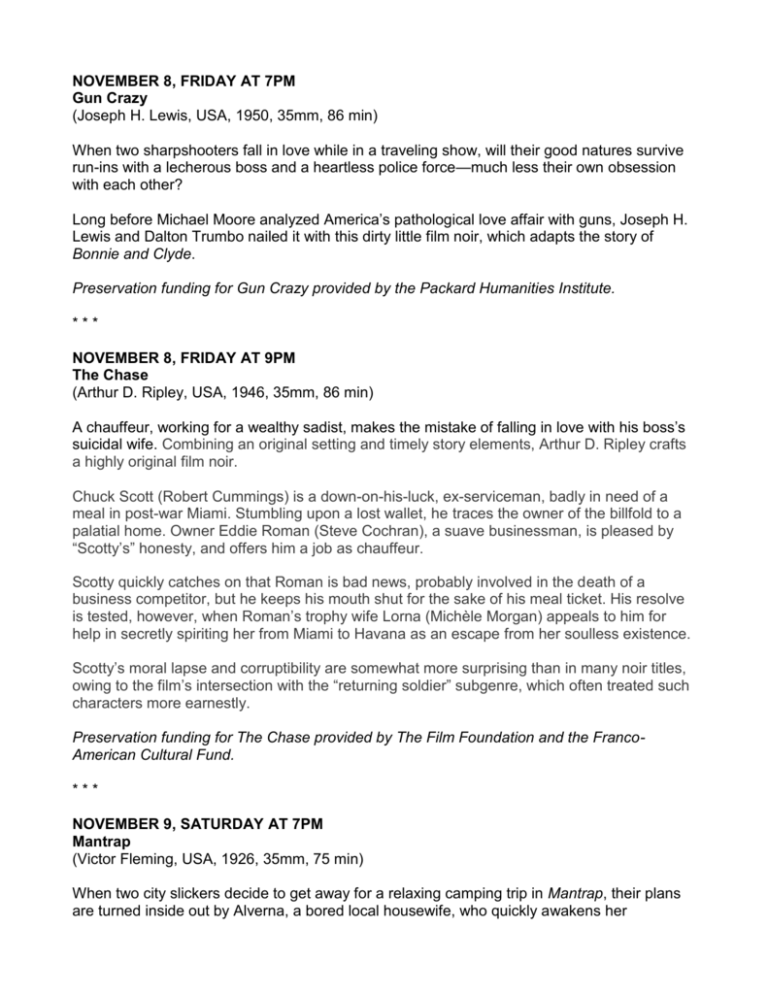
NOVEMBER 8, FRIDAY AT 7PM Gun Crazy (Joseph H. Lewis, USA, 1950, 35mm, 86 min) When two sharpshooters fall in love while in a traveling show, will their good natures survive run-ins with a lecherous boss and a heartless police force—much less their own obsession with each other? Long before Michael Moore analyzed America’s pathological love affair with guns, Joseph H. Lewis and Dalton Trumbo nailed it with this dirty little film noir, which adapts the story of Bonnie and Clyde. Preservation funding for Gun Crazy provided by the Packard Humanities Institute. *** NOVEMBER 8, FRIDAY AT 9PM The Chase (Arthur D. Ripley, USA, 1946, 35mm, 86 min) A chauffeur, working for a wealthy sadist, makes the mistake of falling in love with his boss’s suicidal wife. Combining an original setting and timely story elements, Arthur D. Ripley crafts a highly original film noir. Chuck Scott (Robert Cummings) is a down-on-his-luck, ex-serviceman, badly in need of a meal in post-war Miami. Stumbling upon a lost wallet, he traces the owner of the billfold to a palatial home. Owner Eddie Roman (Steve Cochran), a suave businessman, is pleased by “Scotty’s” honesty, and offers him a job as chauffeur. Scotty quickly catches on that Roman is bad news, probably involved in the death of a business competitor, but he keeps his mouth shut for the sake of his meal ticket. His resolve is tested, however, when Roman’s trophy wife Lorna (Michèle Morgan) appeals to him for help in secretly spiriting her from Miami to Havana as an escape from her soulless existence. Scotty’s moral lapse and corruptibility are somewhat more surprising than in many noir titles, owing to the film’s intersection with the “returning soldier” subgenre, which often treated such characters more earnestly. Preservation funding for The Chase provided by The Film Foundation and the FrancoAmerican Cultural Fund. *** NOVEMBER 9, SATURDAY AT 7PM Mantrap (Victor Fleming, USA, 1926, 35mm, 75 min) When two city slickers decide to get away for a relaxing camping trip in Mantrap, their plans are turned inside out by Alverna, a bored local housewife, who quickly awakens her husband’s jealousy by flirting with the visitors. But when the men fighting for her begin to fight over her future, who—or what—will Alverna finally choose? Paramount Pictures paid $ 50,000 for Sinclair Lewis’ long and justifiably forgotten novel, Mantrap, but happily, the female screenwriters turned Lewis’ misogynistic tirade into a funny comedy romp that is light as a feather. The credit goes to Clara Bow who represents an erotic whirlwind in an otherwise womanless Western wilderness; an outrageous, good-time girl who leads at least two men by the nose, but nevertheless eventually honors her commitment--at least until the next interesting prospect comes along. Bow, of course, perfectly embodied the Jazz Age, the first era in American history to celebrate women’s sexuality as something other than a function of man’s desire. Although Bow had at that point made over thirty films in four years, Mantrap was her breakthrough. Variety noted almost ecstatically in its review of the film: “Clara Bow! And how! What a ‘mantrap’ she is! And how the picture is going to make her!... Miss Bow just walks away with the picture from the moment she steps into camera range.” Preservation funding for Mantrap provided by David Stenn. *** NOVEMBER 9, SATURDAY AT 9PM Midnight Madness (F. Harmon Weight, USA, 1928, 35mm, 65 min) Midnight Madness is a 1928 retelling of The Taming of the Shrew in the most unlikely of settings: a South African diamond mine, where a bitter husband brings his wife after discovering that she married him for money. Far away from the familiar world, however, this husband and wife discover the last thing they thought they’d ever find. In 1925, Cecil B. DeMille, by then one of Hollywood’s most bankable film directors, broke off with Paramount and the confines of the studio system to set up his independent DeMille Picture Corp. While the company’s biggest hit was the highly successful 1927 biblical epic The King of Kings, it mostly produced smaller melodramas, often involving the messy tangles of romance and capricious lovers. Ultimately, however, DeMille’s entrepreneurial efforts were met with a lack of success. In 1928 he returned to the studio system and signed with MGM, later rejoining Paramount, where many of his greatest successes were eventually produced. Midnight Madness is mostly noteworthy as a remnant of this transitional period of DeMille’s career, and those of others. Little remains of the directing career of F. Harmon Weight who although noted in contemporaneous press reports as showing exceptional promise, did not survive Hollywood’s conversion to sound. The stardom of leading lady Jacqueline Logan (who achieved her biggest success as Mary Magdalene in The King of Kings) likewise waned with the onset of talking pictures. Meanwhile, Paramount star Clive Brook, often cast as the reserved Englishman, successfully bridged the sound gap and continued his prolific career in Hollywood and later in his native Britain. Preservation funding for Midnight Madness provided by Sony Pictures Entertainment. *** NOVEMBER 10, SUNDAY AT 7PM Thirty Day Princess (Marion Gering, 1934, USA, 35mm, 74 min) In Thirty Day Princess, the offer of big money bribes an actress to impersonate royalty while engaging with a handsome businessman, played by Cary Grant. Four different writers shared credit for the ebullient yet simple script of Thirty Day Princess, including the great cinematic satirist Preston Sturges. In his autobiography, Sturges stated that he and producer B.P Schulberg disagreed on the final writing credits of the film and that very little of his work was ultimately utilized. Although the old prince-and-the-pauper plot of switched identities was already becoming somewhat trite in Hollywood, critics were mostly kind to the film, claiming it a “neat little combination of Cinderella and Zenda.” Under contract to Paramount at the time, a young Cary Grant was struggling to secure a studio identity in second-tier “tuxedo roles” (several of which were turned down by Gary Cooper). Thirty Day Princess was just such a film. During this period, studio head Adolph Zukor desired to keep Grant for as little money as possible. Knowing that a contract negotiation was forthcoming, Zukor turned down MGM’s request to let Grant star in Mutiny on the Bounty (1935) knowing that it would make him a huge star (Franchot Tone would end up receiving an Oscar nomination for the role). A furious Grant refused to renew his contract with Paramount and would go onto receive almost immediate critical and box-office successes at Columbia and RKO that would define his comedy prowess and leading man charisma. Preservation funding for Thirty Day Princess provided by the Packard Humanities Institute. *** NOVEMBER 10, SUNDAY AT 9PM International House + Busy Bodies Featuring a cast that Film Daily described in 1933 as “a fortune in marquee material,” International House rides high on dizzy turns by W.C. Fields, George Burns, Gracie Allen and Peggy Hopkins Joyce, making her sound film debut. While often described as a “pre-Code” comedy, International House was, indeed, given the once-over by the Hays Office, which declared “the whole picture is vulgar and borders constantly on the salacious.” Not that Paramount cared at the time. The manic, boisterous energy that marks many Hollywood comedies of the early sound era— rarely matched in subsequent decades—owes almost entirely to the presence of vaudeville stars who found second careers on the big screen. The melding of vaudeville’s kaleidoscopic variety aesthetic with Hollywood’s narrative impulse lead to the emergence at the time of a new sub-genre, that film scholar Henry Jenkins' dubbed the “anarchistic comedy.” Following International House, cleanse your palate with a glimpse of Laurel and Hardy’s battle against the fiends of capitalism in Busy Bodies—fiends like grumpy coworkers, unwieldy machinery and their own questionable intellects. BUSY BODIES (Lloyd French, USA, 1933, 35mm, 19 min) INTERNATIONAL HOUSE (Edward Sutherland, USA, 1933, 35mm, 68 min) Preservation funding for International House provided by the Packard Humanities Institute. Preservation funding provided for Busy Bodies by Turner Classic Movies, Jeff Joseph/SabuCat, the Packard Humanities Institute, and the Laurel & Hardy Preservation Fund, including the support of many Sons Of The Desert Tents, and in honor of National Film Preserve: Tom Luddy, Gary Meyer and Julie Huntsinger. *** NOVEMBER 11, MONDAY AT 7PM Supernatural (Victor Halperin, USA, 1933, 35mm, 65 min) In a role that proves she was more than the queen of comedy, Carole Lombard stars in Supernatural, where a quack spiritualist allows a very real phantom to invade her mind. On the strength of their independent horror film White Zombie, a freak success in 1932, Victor and Edward Halperin landed at Paramount on a one-picture deal. For the only time in their careers the Halperins worked at a major studio with access to first-rate production facilities, competent supporting players and a major star in Carole Lombard. The result is a disturbing program picture that reprises the dual performance that had just won Fredric March an Academy Award for Dr. Jekyll and Mr. Hyde (1931) and the exposé of spiritualism that Paramount explored in Darkened Rooms (1929). Supernatural has been overshadowed by the goofy high school pageant that is White Zombie, lacking its predecessor's fairy tale poetics and bursts of Lugosiana. White Zombie may be maddeningly amateurish with a reach far exceeding its grasp, but it resonated with audiences then and continues to radiate a cultural half-life today. Smarter and better made, Supernatural was not a success and has been largely forgotten. Carole Lombard is said to have despised being assigned the movie, making the vitality of her essay in demonic possession all the more impressive as she channels the brassy hysteria of Vivienne Osborne's doomed-to-die murderess, seen indelibly in the first reel. Arthur Martinelli's constantly roving camera, punctuated with unexpected lightning set-ups, is complemented by the uncredited music by Karl Hajos and Milan Roder. It is among the first original dramatic scores of the 1930s (and includes a brief but surprising quotation from Bruckner's Symphony No.3). Preservation funding for Supernatural provided by the Packard Humanities Institute. *** NOVEMBER 11, MONDAY AT 9PM Double Door (Charles Vidor, USA, 1934, 35mm, 75 min) Mary Morris gives a bone-chilling performance as an avaricious spinster in Double Door: when a new sister-in-law comes to visit, she learns that the house contains a secret vault with a family treasure—if only she can escape being locked in with it. Protests from the playwright and producers notwithstanding, New Yorkers who flocked in the fall of 1933 to see Elizabeth McFadden's play Double Door knew it was inspired by the Wendel family of Manhattan, a Gilded Age dynasty of fabulously wealthy eccentrics. What could be more gothic than seven sisters sequestered in a gloomy mansion, tainted by madness, forbidden to marry, presided over by an avaricious brother? Double Door is a dark riff, compressed into a three-act melodrama and led by Anne Revere and Mary Morris, brought directly from the stage, by Paramount, to recreate their roles as the emotionally battered Caroline and the dominatrix Victoria. Double Door is the best kind of filmed stage play, with a strong script and a director who respects his actors. Director Charles Vidor imposes film technique judiciously to punctuate a key revelation with a camera move, an unexpected angle or a lighting shift. One of these is a meticulously plotted in-camera effect breathtaking in its subtlety. The film was a template for the Gaslight school of cat-and-mouse thrillers that would proliferate on the New York and London stage over the next forty years. Preservation funding for Double Door provided by the Packard Humanities Institute. *** NOVEMBER 12, TUESDAY AT 7PM That Cold Day in the Park (Robert Altman, 1969, United States, 35mm, 112 min) Even enthusiastic Robert Altman fans may have missed the film that scored the (then-young) director a contract for M*A*S*H—only in recent years has this strangely poetic psychological thriller gained acclaim as an overlooked masterpiece. In That Cold Day in the Park, Altman dives into the cloistered world of Frances, a lonely spinster, who rescues a young man from the rain, only to reveal how far she will go to keep him as her own. In an age when cinema too often saw women as objects and fear as formulaic, That Cold Day in the Park cast a woman at the helm of a visually subtle but spinechilling tale, and to this day it is a must-see for Altman aficionados. Preservation funding for That Cold Day in the Park provided by the Hollywood Foreign Press Association and The Film Foundation. *** NOVEMBER 13, WEDNESDAY AT 7PM Eadweard Muybridge, Zoopraxographer (Thom Andersen, USA, 1975, 35mm 59 min) One hundred years after his invention of the zoopraxiscope—the world’s first motion picture projector—Eadweard Muybridge, Zoopraxographer tells the story of Muybridge’s life and work during an explosive turning point in photographic history. Thom Andersen’s first feature announced the arrival of one of America’s most significant documentary auteurs. Eadweard Muybridge, Zoopraxographer is at once a biography of Muybridge, a re-animation of his historic sequential photographs, and an inspired examination of their philosophical implications. If the film seems born fully-formed, this is in no small part due to intensive preconceptualization. Writing first in the pages of Film Culture in 1966, Andersen established the framework that would ultimately inform the completed work before it materialized. Working in collaboration with prominent artists and scholars including filmmaker Morgan Fisher (who helped edit the final work), composer Mike Cohen, Muybridge biographer Robert Bartlett Haas, and narrator Dean Stockwell, Anderson took the visual idea as raw material and expanded it into a profound meditation on the nature of vision. The “zoopraxography” of the title speaks to both Muybridge’s practice of motion study—as distinct from photography—and his 1879 device, which enabled the images’ projection. As such, it foregrounds Muybridge’s role in the invention of cinema, and cinema itself as an illusion arising from stillness. Preservation funding for Eadweard Muybridge, Zoopraxographer provided by the Packard Humanities Institute.” *** NOVEMBER 13, WEDNESDAY AT 9PM Robert Frost: A Lover’s Quarrel With the World (Shirley Clarke, Robert Hughes, USA, 35mm 1963, 51 min) Shirley Clarke’s Academy-Award-winning portrait of Robert Frost is a film that sprang from the root of a surprising friendship between the director and poet, two of the 20th century’s most celebrated nonconformists. Filmed in the year before Frost’s death, the film reveals a man who, despite resisting definition as romantic or modernist, carved a foothold in American poetry that would immortalize his work. Shirley Clarke’s powerfully human Frost is depicted through intercut footage of the poet out in the world—speaking to students, touring a naval vessel, delivering a talk at Sarah Lawrence College—and scenes of his purposeful, solitary puttering around the house and grounds of his rural home in Ripton, Vermont. Clarke captures the rhythmic flow of the poet’s life, from gathering up calm to vibrant engagement. Ever one to challenge convention, Clarke allows her subject to comment on her approach. Speaking to his audience at Sarah Lawrence, Frost indicates to the cameras on stage with him: “What you’re seeing here, this sideshow, this is a documentary film going on…but it is a false picture that presents me as always digging potatoes or saying my own poems.” The audience bursts out laughing, caught up in the whimsical spell that the 88-year-old literary giant casts on everyone he encounters, including Clarke. Preservation funding for Robert Frost: A Lover's Quarrel With The World provided by the Packard Humanities Institute and the Academy of Motion Picture Arts and Sciences.
